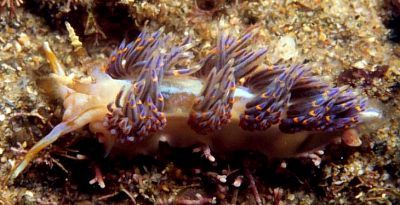
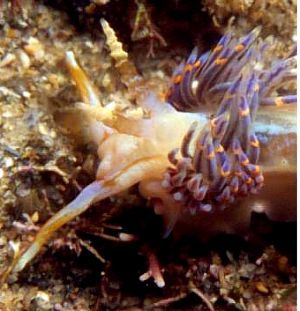
Godiva quadricolor
(Barnard, 1927)
Order: NUDIBRANCHIA
Suborder: AEOLIDINA
Family: Glaucidae
DISTRIBUTION
'Widespread in the Cape Province, South Africa, from Bloubergstrand on the Atlantic coast to Richmond, near East London.' .. Gosliner, T. (1987). Also reported from Western Australia (Willan, 1987) and the Mediterranean (see message from J.L. Cervera)
PHOTO
Pumula, south coast KwaZulu-Natal, SOUTH AFRICA, intertidal zone, July 2001. Photo: Valda Fraser.
'G. quadricolor with its brown cerata with blue, orange, and yellow pigment, is one of the most striking South African aeolids. .... It is a voracious predator, readily consuming other nudibranch species.'.. Gosliner, T. (1987).
References:
• Barnard, K.H. (1927) South African nudibranch mollusca, with descriptions of new species, and a note on some specimens from Tristan d'Acunha. Annals of the South African Museum, 25(1): 171-215, Pls 19, 20.
• Gosliner, T. (1987) Nudibranchs of Southern Africa. Sea Challengers, Jeff Hamann: Tokyo.
• Willan, R.C. (1987) Phylogenetic systematics and zoogeography of Australian nudibranchs. 1. Presence of the aeolid Godiva quadricolor (Barnard) in Western Australia. Journal of the Malacological Society of Australia, 8: 71-85.
Related messages
Godiva quadricolor from South Africa
April 6, 2007
From: Dave Ellis
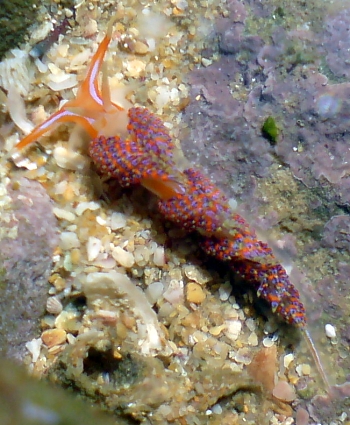
I wonder if anybody can help me to identify the attached pic of a sea slug I saw on the South African coast,
Locality: Port Alfred, 1 foot, South Africa, Indian Ocean, 01 April 2007, natural tidal pool. Length: 30 mm. Photographer: Dave Ellis.
Dave Ellis
dave@thebraaishop.co.za
Ellis, D., 2007 (Apr 6) Godiva quadricolor from South Africa. [Message in] Sea Slug Forum. Australian Museum, Sydney. Available from http://www.seaslugforum.net/find/19808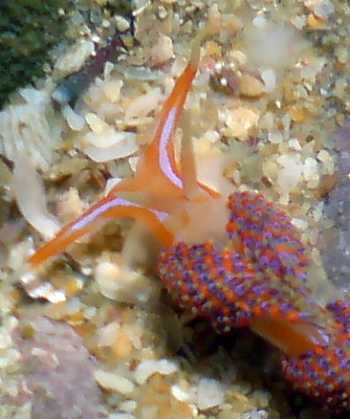
Dear Dave,
Your animal is Godiva quadricolor. When ever I see a photo of this animal from South Africa, I am more convinced that the nudibranch which has at times been identified as this species from Australia, is really Godiva rachelae. See my earlier comments [#16770 ].
Best wishes,
Bill Rudman
Godiva quadricolor from South Africa
June 2, 2006
From: Andrew Higgs
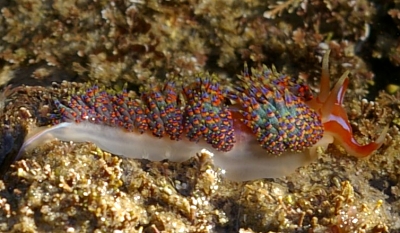
I believe this is Godiva quadricolor?
Could someone please confirm this?
Locality: Port Elizabeth, South Africa, 28 April 2006, Intertidal. Photographer: Andrew Higgs.
Many thanks.
Andrew Higgs
andrew@higgs.co.za
Higgs, A.M., 2006 (Jun 2) Godiva quadricolor from South Africa. [Message in] Sea Slug Forum. Australian Museum, Sydney. Available from http://www.seaslugforum.net/find/16643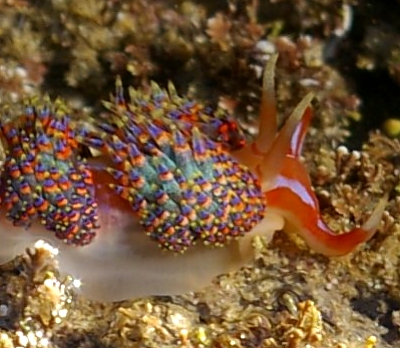
Dear Andrew,
Yes this is Godiva quadricolor. Now that this species has been reported from Western Australia and the Mediterranean, it's nice to get another photo of a South African animal for comparison.
Best wishes,
Bill Rudman
Godiva quadricolor from Western Australia
January 2, 2003
From: Masoud Abadi
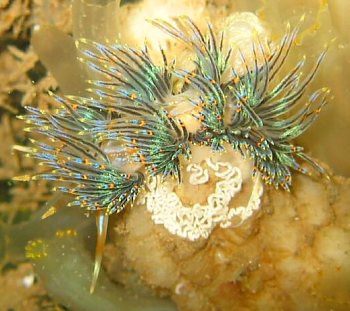

Hi,
I have been using your site to confirm my novice Nudibranch photos and get more info on them. Thanks for a great site, I love it.
On a dive in the Swan River, Perth, Western Australia, 27 December 2002 we captured the beautiful Godiva quadricolor on camera. We think it was laying eggs. Sandy/muddy bottom 13 meters deep. Can you please confirm it was laying eggs… Otherwise what are the white ribbons??
Happy new year :)
Regards,
Masoud
www.theinternetmen.com/dive
masoud@theinternetmen.com
Abadi, M., 2003 (Jan 2) Godiva quadricolor from Western Australia. [Message in] Sea Slug Forum. Australian Museum, Sydney. Available from http://www.seaslugforum.net/find/8759Dear Masoud,
Thanks for the photos. Yes the white string is its egg ribbon. Like most nudibranchs, it lays its eggs in a spiral ribbon. In this case the ribbon is a thin folded string. The upper photo shows the characteristic defence behaviour of species of Godiva and some other genera of aeolids. When disturbed they can erect their cerata. This not only makes them look bigger, but defends their body by surrounding it with the stinging nematocysts that are stored in the cnidosacs at the tips of the cerata.
Best wishes,
Bill Rudman
Godiva quadricolor from Mediterranean
July 30, 2002
From: Juan Lucas Cervera
Hi Bill,
I'm in agreement with your comments about this species in Britt & Kirsty's and Jun Imamoto's messages. Only a little data. Godiva quadricolor has been recorded also in the Mediterranean (Fusaro Lake, Italy). You can see a photo of this animal in the Cattaneo-Vietti's et al (1990) Atlas of the Mediterranean Nudibranchs [Pl 13, fi. 4] under the name Facelina coronata (wrongly identified obviously).
Regards.
Lucas.
lucas.cervera@uca.es
Cerveras, J.L., 2002 (Jul 30) Godiva quadricolor from Mediterranean. [Message in] Sea Slug Forum. Australian Museum, Sydney. Available from http://www.seaslugforum.net/find/7657Thanks Lucas,
Now you mention it, I had puzzled over that photo a couple of times when browsing through that book.
Cheers,
Bill Rudman
Re: Godiva quadricolor
July 27, 2002
From: Britt and Kirsty
Hello,
My friend Britt and I (Kirsty)are doing a university research assessment on the Godiva quadricolor at Griffith University on the Gold Coast [Queensland, Australia]. Our focus is on the organism's biology and also its ecological and socio/economic implications. Any information you are able to provide us with would be greatly appreciated.
Thank you,
Britt and Kirsty
britt_1982@hotmail.com
Britt and Kirsty, 2002 (Jul 27) Re: Godiva quadricolor. [Message in] Sea Slug Forum. Australian Museum, Sydney. Available from http://www.seaslugforum.net/find/7635Dear Britt and Kirsty,
I am not quite sure why you have chosen, or been given, Godiva quadricolor, as a study animal. It is known from South Africa and Willan (1987) has reported it from Western Australia. I know of no records from Queensland. Like most opisthobranchs, we know little about its biology and natural history. As to its 'socio/economic implications', I am not too sure what you mean by that, but I can confidently say we don't know anything about them. I guess you have had a look at the species' Fact Sheet and other messages on this page. I don't know of any other references on the species. For more general information on aeolid biology have a look at the General Topics Index.
Best wishes,
Bill Rudman
Godiva quadricolor 'swarming'
August 24, 2001
From: Valda Fraser

Dear Bill
For the past month or so I have been sharing "my pool" with so many Godiva quadricolor that I'm too scared to walk about for fear of treading on one. And now .... they're all gone and I'm missing them.
A while ago I send an awful image. I hope you'll like these two better.
Regards
Valda Fraser
valdafraser@mweb.co.za

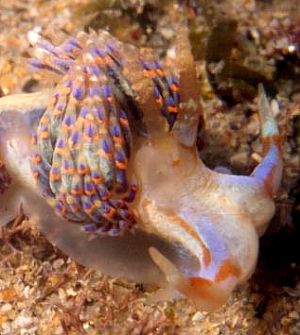
Dear Valda,
Thanks very much for thinking of us. Apart from natural curiosity about the colour pattern of this species I have been interested in seeing some good photos of this species so I can compare them with similarly coloured animals from other parts of the Indo-West Pacific. These photos will be a great help.
I guess the 'pool' you mention is the one at Pumula that you mention in your earlier message?
Best wishes,
Bill Rudman
Godiva quadricolor from South Africa
June 5, 2001
From: Valda Fraser
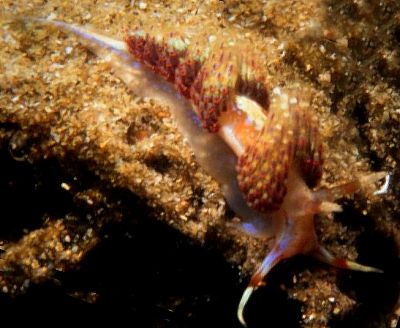
Dear Bill
I just don't know! Please help. Thanks.
Locality: Pumula, south coast KwaZulu-Natal, SOUTH AFRICA, intertidal zone
Date: April 2001
Size: 4 cm
Regards
Valda Fraser
valdafraser@mweb.co.za
Fraser, V., 2001 (Jun 5) Godiva quadricolor from South Africa. [Message in] Sea Slug Forum. Australian Museum, Sydney. Available from http://www.seaslugforum.net/find/4293Dear Valda,
This is Godiva quadricolor which Terry Gosliner says is widespread in the Cape Province and is particularly common on the Cape south coast, ranging from the intertidal to 15m. He says it is a voracious predator readily consuming other species of nudibranchs.
Best wishes,
Bill Rudman
Godiva quadricolor? from South Africa
July 21, 1999
From: Ernest C.J. Seamark
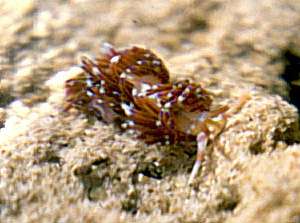
This unknown species was found under rocks in the Treasure Beach intertidal zone, South Africa on 29 April 1998.
[Treasure Beach is in Durban, KwaZulu Natal, South Africa.]
Ernest Seamark
kearneyt@biology.und.ac.za
Seamark, E.C.J., 1999 (Jul 21) Godiva quadricolor? from South Africa. [Message in] Sea Slug Forum. Australian Museum, Sydney. Available from http://www.seaslugforum.net/find/1046Dear Ernest,
This looks to me as though it could be Godiva quadricolor. It doesn't seem to be quite as colourful as Terry Gosliner's photos but that would be my guess.
Bill Rudman.
Rudman, W.B., 1999 (Jul 21). Comment on Godiva quadricolor? from South Africa by Ernest C.J. Seamark. [Message in] Sea Slug Forum. Australian Museum, Sydney. Available from http://www.seaslugforum.net/find/1046